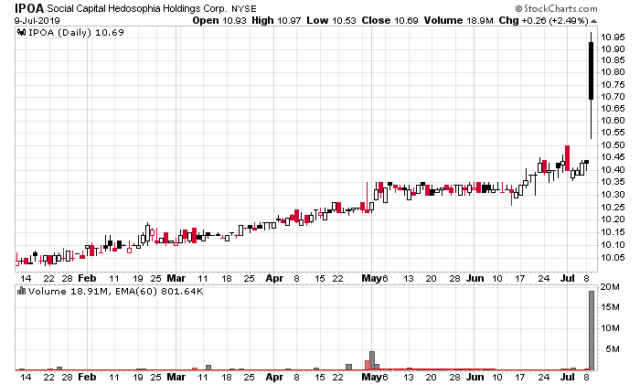I wrote back in 2019 about the original SPAC that took Virgin Galactic (NYSE: SPCE) public and my thoughts haven’t changed much from today.
Indeed, they had their hype – astute traders gamblers have seen their capital go from $10 up to $35, down to $15, up to $60, down to $15, up to now $50, in what is oddly like the trajectory the Virgin Galactic spaceship flies itself.
Today the main headline is Richard Branson flying out in one of those spaceships, in what was a massive marketing exercise – I bet Branson was jealous of all of the hype that Elon Musk was stealing over the past few years.
Much to their credit, the rocketship flight made it – they got their 70 seconds of propellant out and made it to the height of about 280,000 feet (or about 85 kilometers above the ground).
The marketing exercise is caused by the perverse anticipation of disaster, similar to how some people watch automobile racing to see car crashes.
This is all great and everything, and SPCE is likely going to trade up Monday morning, but I deeply suspect it will be a great time to short the stock. I will not be – I only mentally trade these sorts of situations with a million eyeballs and daytraders that will inevitably be crowding around the stock.
The issue is that the while the venture tries to do cool things, from an engineering perspective sending a craft out 85 kilometers over the surface is much, much more trivial than it is to send it to a practical altitude (low earth orbit) with the energy required to keep it there – Virgin Galactic’s ship just requires it to go up, and it glides to the bottom. A rocket ship going into low earth orbit requires it to go up (for example, the international space station is about 420 km above the surface), but also horizontally (about 28,000km/h) to keep it in perpetual free-fall. This requires a lot more energy to perform, and a lot more engineering with the design frame and engines which need to scale up disproportionately in order to haul these loads into orbit (mainly to handle the amount of fuel required to get there). This isn’t a matter of “extending the frame” to fit further usages – that design is hard-wired.
Amazon’s Jeff Bezos’ Blue Origin has a different system, the New Shepard rocket ship (which unlike Virgin Galactic, starts on the ground instead of on an airplane), which is designed to send people in a capsule up to around 105km – with a 110 second rocket burn. They will launch in just over a week. The same analysis applies to them as well. Scaling up to a point where you can do SpaceX-type activities requires a lot more engineering than slapping on a few extra engines and increasing the size of the fuel tank.
As such, the Virgin Galactic ship, as currently designed, has little use other than a tourism vessel. This was the intent of the design, the company was not meant to be other than an amusement factory. Cool but useless – and it’s a business model that almost guarantees there will be no repeat customers, similar to the skywalk at the Grand Canyon.
